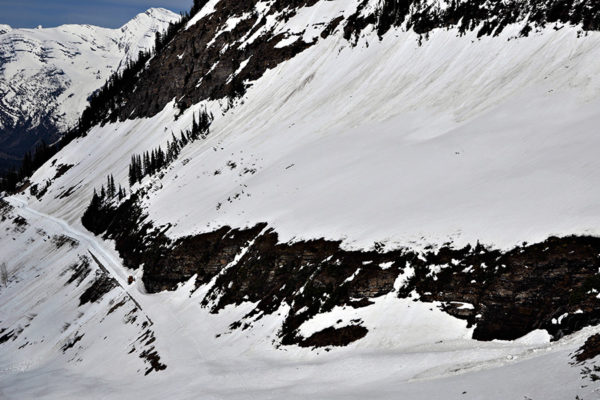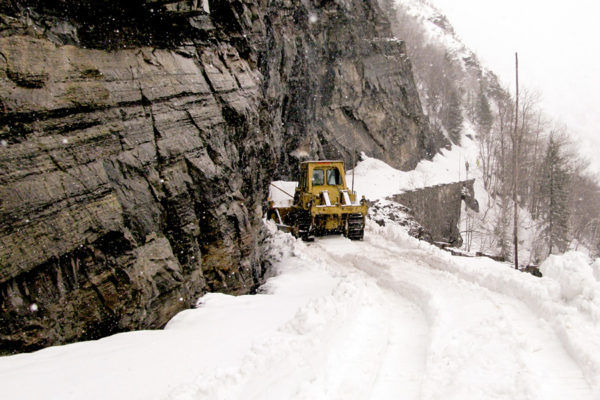Uncovering the Sun
Meet the crew of specialists who take on the colossal, and often harrowing, job of clearing mountains of snow from Glacier Park’s famed Going-to-the-Sun Road
By Dillon Tabish
They dodge tumbling boulders and surging avalanches. Hunkered inside high-powered heavy equipment, they navigate a narrow, often invisible path that ascends into the sky, twisting and turning up the mountainside along jagged cliffs and over a minefield of unstable surfaces. They sculpt walls of winter in the cradle of ancient glaciers, cutting through 30- to 50-foot drifts and chewing up 4,000 tons — 8 million pounds — of snow per hour, 100,000 cubic yards per spring.
These high-pressure operations are part of the Glacier National Park Road Crew’s age-old mission prepping the iconic Going-to-the-Sun Road for tourist season, a spring rite that plays a pivotal role in the park and surrounding region. Starting April 1 and usually spanning 10 weeks each year, the 20-person crew braves this 50-mile highway, one of the most treacherous thoroughfares on the continent and the primary path into Glacier.
While the masses eagerly await the Sun Road’s opening, this tight-knit team of equipment operators approaches its journey with a missionary zeal. Antsy excitement spreads throughout the crew.
“It’s like waiting for Christmas,” Brian Paul, the work leader for Glacier’s west side crew, said. “At the end, it’s like, ‘OK, I’m tired of Christmas.’”

Last week, the daunting task was officially underway as two groups — one on the west side of the park and another on the east side — embarked on this year’s transmountain marathon.
“We’re raring to get going,” Paul said.
For about as long as Glacier’s highway to the sky has existed — 84 years — there has been the need for an industrious crew to dig it out from winter’s wrath. It’s one of the most unique challenges in the National Park Service and has generated creative actions in the past. In the 1960s, the park experimented with U.S. Air Force jets that flew past the Garden Wall and broke the sound barrier in an effort to trigger avalanches and reduce the number of delayed slides that could hamper plow crews. Dynamite has also been tossed out as an idea.
And for just as long, there has been constant outcry from visitors and connected communities craving Glacier’s full availability as early as possible. But plowing the road must mesh with a sensitive set of standards in a pristine and protected national park such as Glacier.
For all the attention and anticipation surrounding their work, these equipment operators labor in relative obscurity in the remote and rugged Crown Jewel of the Continent. They are both pioneers and trailblazers.
The majority of Going-to-the-Sun Road — about 35 miles — gets buried starting each fall and sometimes lasting through early July. To uncover months’ worth of snowfall, the road crew uses a fleet of heavy-duty machines, including four dozers, four excavators, three rotary plows and two bobcats. Some of this burly equipment was formerly used by the U.S. military and is now serving the country in a uniquely different way.
“This job is like the Holy Grail of equipment operating,” Christian Tranel, an equipment operator entering his seventh season, said.
Tranel grew up in Bigfork and served in the Army before working in the private sector with heavy equipment, focusing on highway projects. He’s now one of the skilled operators who frequently “pioneers” the Sun Road as one of the lead machines.
“I love being in the mountains. We’re up there by ourselves,” he said. “I like the excitement and the adrenaline of pioneering. It’s exciting but it’s kind of scary, too.”
Avalanches, usually in the dozens, pour over many portions of road and litter the two-lane road with debris, including massive trees and boulders. Tumbling rocks, often occurring naturally but sometimes triggered by bighorn sheep, frequently pummel the road. Wind reshapes the path, creating drifts, often unstable, that can grow as high as 80 feet into the sky and swallow 55,000-pound bulldozers in an instant.
“Removing the snow isn’t the scary part for me because we have control over that,” Paul said. “It’s the unknowns, like avalanches and rock falls.”
“If you’re not scared,” he added, “you shouldn’t be up there, because that’s what keeps you safe.”

In May of 1953, crews had made good progress clearing the Sun Road before a late spring storm hit the high country. An avalanche caught four Glacier employees who were clearing the road. Bill Whitford was thrown 300 yards down the mountain and killed. Another crewmember, George Beaton, also died in the slide. Fred Klein was badly injured, and Jean Sullivan, who was inside a large rotary snowplow, was buried for 7.5 hours before being rescued.
The worst year for avalanches in recent memory occurred in 2009, when hundreds of slides were reported throughout Glacier, causing severe setbacks for crews.
Paul has first-hand experience with the dangers of the job. A few years ago, he was walking between equipment when a rockslide erupted. A basketball-sized rock narrowly missed his head and hit his backpack.
“There’s certain places you just don’t hang out,” he said.
Due to this unique working environment, the road crew is a tight-knit bunch, each devoted to accomplishing the monumental task and ensuring everyone returns home alive. During spring, they see more of each other than their families, working 10 hours a day for four days a week in the high country of Glacier.
“Everybody relies on each other,” Paul said.
Plowing the Sun Road requires a meticulous mindset. It’s also a team effort that prioritizes safety over speediness.
“Everything is based on safety,” Paul said. “We look at a hazard and figure out how we can mitigate it before we go into anything.”
Before the plow crews arrive in the pre-dawn hours to begin the day’s work, avalanche specialists check the weather and snowpack conditions and craft a daily report. This requires them to regularly ski into the upper portions of the park to see what lies ahead for the plows.
“Those guys are animals,” Paul said. “They give us the green light before we go anywhere.”

As another precautionary measure, spotters hike up ahead of the plows and act as watchmen, staring at the landscape all day to spot potential hazards. This often requires toughing out blizzards or braving frigid temperatures for hours at a time. Regardless of conditions and weariness, they can’t take their eyes off the mountains.
“The toughest guys up there are the spotters. That’s the hardest job,” Paul said. “They stand there all day, traversing the snow on foot and watching for rocks and avalanches. If they see something moving, they have to quickly get on the radio and warn everybody.”
As the lead machine operator, Tranel will begin at the height of the snowpack and chisel downward. Meanwhile, excavators focus on the mountainside above the road, clearing everything that could tumble downward. Behind the lead machines, crews dig through a heavy layer of ice that cakes the pavement, all while being sensitive to the historic road.
“You never know what it will be like until you get up there,” Paul said.
Paul grew up in the Browning-East Glacier area and worked for the Bureau of Reclamation for eight years before joining Glacier’s road crew nine years ago. When he first started, he would check the site data at Flattop Mountain to see what the snowpack looked like.
As of last week, the SNOTEL site showed slightly above-average snow depth, around 130 inches, which is similar to a year ago.
But as Paul has learned, it’s best to avoid forming preconceived notions.
“I try not to worry about how deep it’s going to be. Everything can change,” he said. “I take it a day at a time and just focus on the section we’re going to work on today. Everything up above, I can’t do anything about it. You have to stay focused on that day’s job. It’s a different challenge every day.”
It’s not uncommon for the crew to plow one stretch of road only to have it blanketed overnight, requiring a tedious rerun.
“Sometimes you’ll get up there and work all day and come back, and it snowed two feet,” Paul said. “So you’ll have to hike back up to get machines and start over again.”
![]() Sometimes the most challenging aspect of each day’s work is simply finding the actual road. Visibility is frequently reduced by fog. In the upper alpine stretches of road, which trace cliffy geography, any remnants of a man-made pathway are gone.
Sometimes the most challenging aspect of each day’s work is simply finding the actual road. Visibility is frequently reduced by fog. In the upper alpine stretches of road, which trace cliffy geography, any remnants of a man-made pathway are gone.
“There are a lot of places where it disappears,” Tranel said of the Sun Road.
Instead of depending on new-age technology, which is rendered mostly useless in the solitary confines of the park’s wild interior, they rely on each other and an intimate knowledge of the landscape to guide them, old-fashioned acumen that harkens back to past generations of plow crews.
This is easier said than done, especially in the Rimrock area near Mount Oberlin, where depending on imaginary lines is an exercise in faith.
“At the end of that day, that’s when you park and get out and say, ‘I’m done for the day,’” Paul said.
Indeed, the grueling work and high-octane stress weigh heavily.
“It starts wearing on you,” Paul said. “Sometimes somebody starts getting burned out and we’ll roll it around to put somebody else out front.”
A long day inside the cab of a bulldozer, occasionally on edge and sometimes literally on the edge of a cliff, can play tricks on your mind, especially when you’re all alone.
“Sometimes you have to take five minutes and stop and collect your thoughts,” Tranel said. “You have to rest your mind because it’s so stressful.”
The final push arrives at Logan Pass and the so-called Big Drift, where the most snow typically piles up. Sometimes snowpack grows upwards of 80 feet and buries all but the roof of Logan Pass Visitor Center. Crews on the east and west sides converge at these two points and tackle them together due to the scope of work. This often requires using hand shovels near the visitor center. Water from snowmelt creates potholes and tunnels that can create hazards.
“It takes years of experience,” Paul said. “You start learning where those holes are, what to do in certain places and where not to go.”
The latest opening of the full length of Going-to-the-Sun Road was July 13 in 2011. That year, crews were hampered by a blustery spring that saw heavy snowpack and relentless snowstorms that erased plow progress on a regular basis. The earliest opening for the entire Sun Road was May 16 in 1987.
“It opens when it does,” Paul said. “The weather plays a huge part in when the road opens. And when it’s safe enough for the public. You can’t have a whole bunch of hang fire up there when people start coming up the road.”
Despite the hazards and stress that come with the job, none of the crewmembers are eager to shop resumes elsewhere.
“It’s a dream job,” Tranel said. “My favorite time of year is right now.”
“Being up there, you get to watch the park come alive,” Paul said. “You start seeing animals come out and it’s pristine. You break for lunch and sit on a dozer and look around, and it’s just amazing.”
And once the mission is complete, the crew is ready to welcome visitors to experience a national treasure.
“We’re up there for three months by ourselves,” Paul said.
“Now they can have it.”